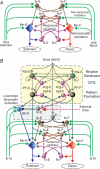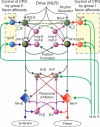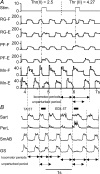Modelling spinal circuitry involved in locomotor pattern generation: insights from the effects of afferent stimulation
- PMID: 17008375
- PMCID: PMC1890432
- DOI: 10.1113/jphysiol.2006.118711
Modelling spinal circuitry involved in locomotor pattern generation: insights from the effects of afferent stimulation
Abstract
A computational model of the mammalian spinal cord circuitry incorporating a two-level central pattern generator (CPG) with separate half-centre rhythm generator (RG) and pattern formation (PF) networks has been developed from observations obtained during fictive locomotion in decerebrate cats. Sensory afferents have been incorporated in the model to study the effects of afferent stimulation on locomotor phase switching and step cycle period and on the firing patterns of flexor and extensor motoneurones. Here we show that this CPG structure can be integrated with reflex circuits to reproduce the reorganization of group I reflex pathways occurring during locomotion. During the extensor phase of fictive locomotion, activation of extensor muscle group I afferents increases extensor motoneurone activity and prolongs the extensor phase. This extensor phase prolongation may occur with or without a resetting of the locomotor cycle, which (according to the model) depends on the degree to which sensory input affects the RG and PF circuits, respectively. The same stimulation delivered during flexion produces a temporary resetting to extension without changing the timing of following locomotor cycles. The model reproduces this behaviour by suggesting that this sensory input influences the PF network without affecting the RG. The model also suggests that the different effects of flexor muscle nerve afferent stimulation observed experimentally (phase prolongation versus resetting) result from opposing influences of flexor group I and II afferents on the PF and RG circuits controlling the activity of flexor and extensor motoneurones. The results of modelling provide insights into proprioceptive control of locomotion.
Figures








Similar articles
-
Modelling spinal circuitry involved in locomotor pattern generation: insights from deletions during fictive locomotion.J Physiol. 2006 Dec 1;577(Pt 2):617-39. doi: 10.1113/jphysiol.2006.118703. Epub 2006 Sep 28. J Physiol. 2006. PMID: 17008376 Free PMC article.
-
Flexor reflex afferents reset the step cycle during fictive locomotion in the cat.Exp Brain Res. 1998 Oct;122(3):339-50. doi: 10.1007/s002210050522. Exp Brain Res. 1998. PMID: 9808307
-
Parallel reflex pathways from flexor muscle afferents evoking resetting and flexion enhancement during fictive locomotion and scratch in the cat.J Physiol. 2005 Nov 15;569(Pt 1):275-90. doi: 10.1113/jphysiol.2005.095505. Epub 2005 Sep 1. J Physiol. 2005. PMID: 16141269 Free PMC article.
-
Modeling the mammalian locomotor CPG: insights from mistakes and perturbations.Prog Brain Res. 2007;165:235-53. doi: 10.1016/S0079-6123(06)65015-2. Prog Brain Res. 2007. PMID: 17925250 Free PMC article. Review.
-
Chapter 2--the spinal generation of phases and cycle duration.Prog Brain Res. 2011;188:15-29. doi: 10.1016/B978-0-444-53825-3.00007-3. Prog Brain Res. 2011. PMID: 21333800 Review.
Cited by
-
Epidural Electrical Stimulation: A Review of Plasticity Mechanisms That Are Hypothesized to Underlie Enhanced Recovery From Spinal Cord Injury With Stimulation.Front Mol Neurosci. 2020 Sep 2;13:163. doi: 10.3389/fnmol.2020.00163. eCollection 2020. Front Mol Neurosci. 2020. PMID: 33013317 Free PMC article.
-
Control of Mammalian Locomotion by Somatosensory Feedback.Compr Physiol. 2021 Dec 29;12(1):2877-2947. doi: 10.1002/cphy.c210020. Compr Physiol. 2021. PMID: 34964114 Free PMC article.
-
Fictive Scratching Patterns in Brain Cortex-Ablated, Midcollicular Decerebrate, and Spinal Cats.Front Neural Circuits. 2020 Feb 27;14:1. doi: 10.3389/fncir.2020.00001. eCollection 2020. Front Neural Circuits. 2020. PMID: 32174815 Free PMC article.
-
Modeling zero-lag synchronization of dorsal horn neurons during the traveling of electrical waves in the cat spinal cord.Physiol Rep. 2013 Jul;1(2):e00021. doi: 10.1002/phy2.21. Epub 2013 Jul 8. Physiol Rep. 2013. PMID: 24303110 Free PMC article.
-
Modeling Post-Scratching Locomotion with Two Rhythm Generators and a Shared Pattern Formation.Biology (Basel). 2021 Jul 14;10(7):663. doi: 10.3390/biology10070663. Biology (Basel). 2021. PMID: 34356518 Free PMC article.
References
-
- Booth V, Rinzel J, Kiehn O. Compartmental model of vertebrate motoneurons for Ca2+-dependent spiking and plateau potentials under pharmacological treatment. J Neurophysiol. 1997;78:3371–3385. - PubMed
-
- Buford JA, Smith JL. Adaptive control for backward quadrupedal walking. III. Stumbling corrective reactions and cutaneous reflex sensitivity. J Neurophysiol. 1993;70:1102–1114. - PubMed
Publication types
MeSH terms
Grants and funding
LinkOut - more resources
Full Text Sources
Other Literature Sources
Medical
Miscellaneous

